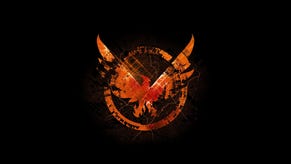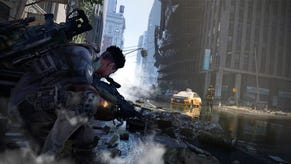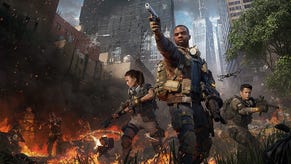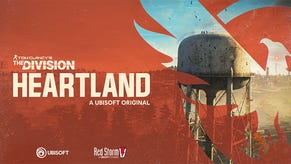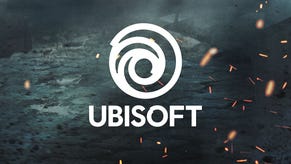The Division PS4 Review: Gritty. Brutal. Brilliant.
Taking back New York is a tough and challenging experience - but also a thoroughly enjoyable one.
This article first appeared on USgamer, a partner publication of VG247. Some content, such as this article, has been migrated to VG247 for posterity after USgamer's closure - but it has not been edited or further vetted by the VG247 team.
Wandering the streets of The Division's Manhattan is a sobering experience. I've explored many a video gaming post-apocalyptic environment over the years, but I don't think I've ever seen one quite as depressingly fully realized as this. This is a city that feels like it's just slipped into the abyss. Bodies lie in the streets. Abandoned cars are everywhere. Garbage and roadblocks add to the chaos. Survivors sift through the wreckage, and wander the streets in a desperate daze. It all feels terrifyingly realistic, and horribly dystopian.
Set in the weeks following the release of a weaponized virus that has decimated most of the population, The Division casts you as a member of the eponymous sleeper unit that's trained to mobilize during times of severe crisis. Its objective: to bring law and order back to the remnants of society. What that means for you is heading into what remains of Manhattan as a one man judge, jury, and executioner to attempt to fix critical infrastructure, and protect the populace from the criminal elements who have taken over much of the city by force.
In other words, The Division is a third-person, cover-based MMO shooter with RPG elements in which you explore the sandbox world of Manhattan, taking on missions to earn experience to level you up, as well as garner new weapons and equipment to help you take on the increasingly challenging threats you'll inevitably encounter as you make progress.
The action opens up in Brooklyn, with a series of training missions designed to get you up to speed on the mechanics of the game. It's all quite straightforward stuff, and works well to teach you the basics of the cover mechanics, how to navigate obstacles, and, most importantly, get a feel for your weapons. Before long, however, you're heading across the East River into Manhattan itself, where you're dropped off at Camp Hudson in Chelsea, where the game begins proper.
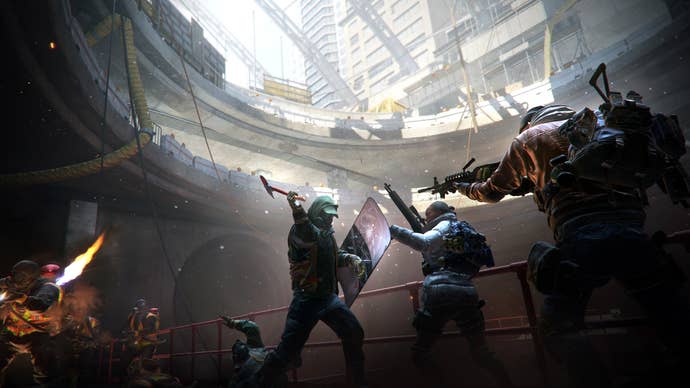
TUESDAY MORNING
I haven't been this excited about a game for a long while. Having played both Betas of The Division, I pretty much know what I'm getting into, and I'm hoping that what I've already experienced is an accurate taste of what's to come. I love sophisticated shooters, and that's what The Division ostensibly is. Sure, it has role-playing elements, but at its core, it's really a shooter. Well, a cover-based shooter to be more exact.
Having blitzed through the starter missions, I find myself in familiar territory at Camp Hudson, and immediately make a bee-line for the base of operations, with the intent of getting that up and running as quickly as possible. Doing so requires me to fight a pocket of criminal resistance outside the base, and that goes smoothly enough. I generally like The Division's gunplay, and while it does occasionally feel a tad heavy, aiming and shooting is smooth and accurate enough.
Base operational, I head to my first mission. I decide to tackle it solo to see how it is, and I soon run into trouble. It seems the mission I've chosen is slightly too high of a level for me, and I just don't quite have the DPS to take out the enemies with sufficient speed to stop them from overwhelming me. After a few more tries, I decide to give up. Not the most auspicious start for my agent, but I realize I'm getting ahead of myself by trying something I'm not quite ready for. Lesson learned: Don't attempt to solo missions in The Division when you're way below the recommended starting level. It makes the game frustratingly challenging.
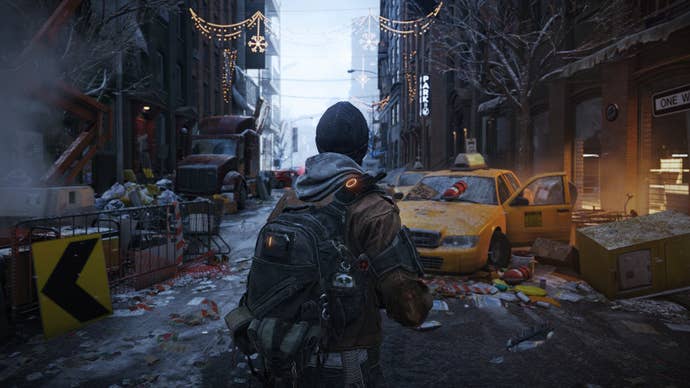
So instead I go out into the streets and complete a few encounters, which are a lot easier. Encounters are like basic missions, and vary in size from a simple takeover of a small yard to reclaiming a waterworks, which pits me against waves of enemies while I defend the installation. I have a lot of fun doing this, and while I do die a couple of times while working out the best way to prevent myself from being overrun, I eventually emerge victorious. One thing's for sure, The Division isn't a pushover, and unless you take on missions and encounters that you're over-leveled for, expect a fairly decent level of challenge.
That's because, on the whole, enemies are quite intelligent, and try to flank and generally overrun you with superior numbers. Sometimes they do stupid things like hide behind a barrier with parts of their body exposed so you can shoot at them, but based on my experiences with The Division so far, the enemies mostly aren't cannon fodder. They're also pretty accurate shots, and if you stand still for any period of time, you'll be riddled with bullets in fairly short order. Instead, you need to make use of cover and stay mobile when fighting, which makes the action feel quite dynamic and exciting.
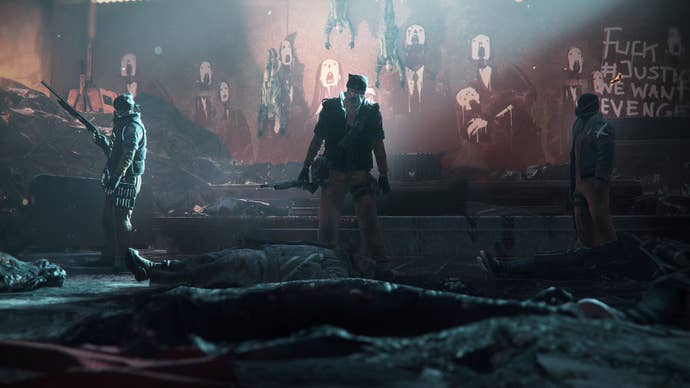
One thing I'm noticing while playing is that The Division has quite a lot of footslogging as you travel around its enormous environment. There are some fast-travel options to go back to your base, for example, but for the most part, you have to run through the streets of Manhattan as you travel from place to place. This isn't as straightforward as it sounds, however. There are criminals everywhere, and it's very easy to run right into a pocket of resistance if you’re not paying proper attention, so you need to stay alert as you wander around. These random events help make the environment feel dangerous and filled with threats, and break up journeys into moments of interest.
As I reach level six, I decide to tackle the mission that thwarted me initially, so I head over to its location and use the matchmaking system to check out how well it works. It's great! It takes a short 30 seconds to match me with another player, and we both head into Madison Square Gardens to rescue some doctors and nurses who are being held hostage there. The mission goes well, and we pretty much ace it between the two of us: Definitely a far cry from my solo attempt three levels ago. Missions scale according to the number of players in the party, and there are definitely a lot more enemies for two players than when I played it alone – but even so, I'm doing considerably more damage than I was before, and that enables me to take out enemies quickly. My temporary teammate is a level above me, and he's doing even better, and neither of us dies as we head through the mission's numerous locations, and chew our way through waves of enemies and the fairly tough end boss.
It's a fun mission, and I pick up some decent loot from fallen enemies along the way, which I equip. So far, the loot system seems pretty good. Items can be acquired from downed enemies, as well as random crates dotted around the map, and as rewards for completing missions and encounters. There's also a crafting system, which I haven't explored yet, although I have picked up a few gun parts, as well as some electronics, and cloth. Apparently you need to acquire blueprints to be able to craft, and I've noticed a couple of missions and encounters that award them. I'll try these out a little later, and see what I can make.
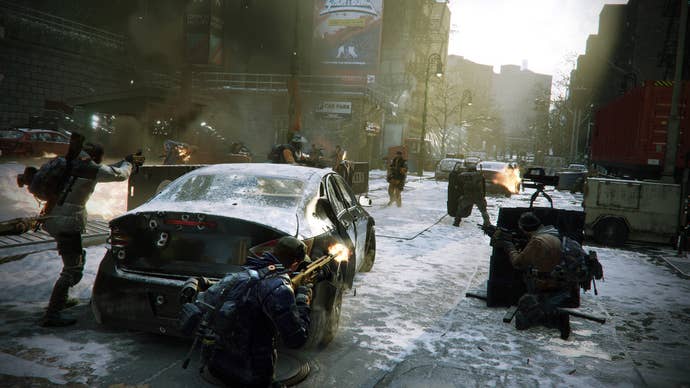
However, first things first – I want to hit the Dark Zone, which I'll be doing this afternoon and tonight. This is the PvP area of The Division, which is quite brutal and unforgiving, and I'm looking forward to seeing how I get on there. I really enjoyed what it had to offer in Beta – it's a truly dangerous place filled with tough, tough enemies and, of course, players who can attempt to kill you if they so desire, and that's a recipe for some adrenaline-fueled gameplay. I'll give you a full report in my next update.
In the meantime, I've had a great time in The Division so far, and it hasn't disappointed. Well, apart from trying to tackle missions that I wasn't quite ready for. It seems that The Division's level demarcation is quite significant, and I'll be mindful not to take on missions whose recommended level I haven't yet reached. But other than that, The Division is challenging, and very gritty. Definitely a very, very promising start and I can't wait to get back to it.
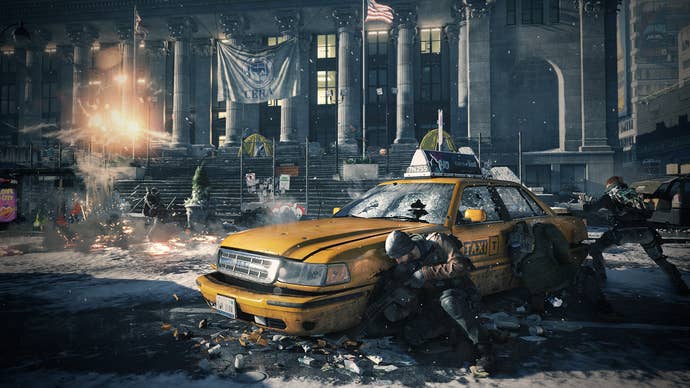
TUESDAY NIGHT
Last night I entered the Dark Zone… and had a really pleasant time. Which is something I wasn't expecting from The Division's brutal and unforgiving PvP area. Basically, I was lucky enough to run into several individuals who were running a circuit between landmarks, and were all helping one another out. I tagged along with them, shooting at the elite Dark Zone enemies we encountered, and reviving those who were unfortunate enough to get nailed during battle. I experienced this sort of mutual cooperation several times during Beta, and was always relieved when it happened. It's definitely a lot nicer than being shot at by groups of players who are preying on individuals, which also happened to me more than a few times.
Nobody shot anyone (at least, not deliberately), and we all helped one another extract our loot several times during the hour or so the group stayed together. Whether I'll get this lucky again remains to be seen, but I'm encouraged that, so far at least, players I've encountered in the Dark Zone are more interested in leveling up and getting loot from NPCs, than killing other players and flagging themselves as rogue.
After the group broke up, I did spend a little time soloing in the Dark Zone, and found it's a pretty tough environment when you're on your own. The NPCs are hard to take down as an individual – especially when there's a group of them – and you need to expend a lot of ammo to rack up kills. Definitely a place best enjoyed when you're in a group, or are working with other players under a mutual understanding of cooperation.
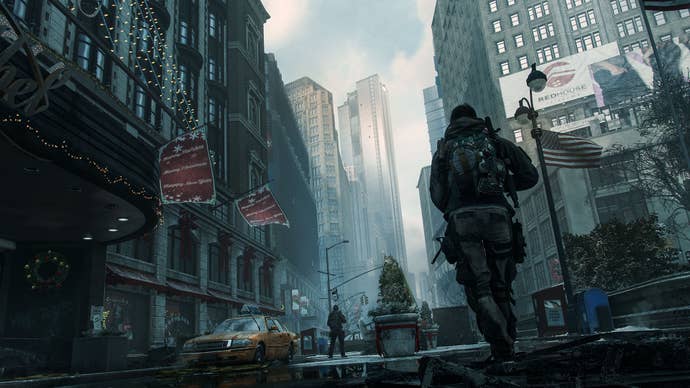
Once I'd finished in the Dark Zone, I decided to run a mission, and used the matchmaking system, which quickly and efficiently grouped me with three other players. So far I've been really impressed with matchmaking, and it hasn’t failed to find other players for me to group with whenever I've looked. The mission we tackled was set in a huge department store, where we hunted for infected dollar bills while fending off waves of hostiles. I really enjoyed the action – the department store was very open, and the enemies engaged us from multiple angles, meaning we had to constantly keep on the move to stay out of the line of fire. Several of the enemies were cleaners equipped with flame throwers, and that also helped dial up the level of challenge.
What I've noticed so far is that missions have all been essentially the same in terms of their fundamentals – make your way through an environment, shoot at the waves of enemies that attack you, and take out the boss at the end. However, their settings have made each firefight feel different from one another. From the more linear Lincoln Tunnel mission to the open department store, each has set its own challenge that has felt different enough for it to not feel like I'm doing the same thing over and over again. I'm interested to see whether this holds up over the long-term, but so far I've been impressed with the variety the game offers, even though you're basically running a series of shoot-outs.
At the end of my session, I returned to my Base of Operations to upgrade it with the supplies I've been awarded for completing missions. I really like the way this aspect of the game works: The Base has three different wings; medical, tech, and security, and each can be upgraded by building out different facilities using your supplies. So far, I'm doing very well on the medical side of things, and have added a virus lab, quarantine, and a pediatric care facility – each of which has given me additional mods, perks, and skills that I can use. This has essentially enabled me to customize my character by choosing facilities that deliver abilities I'm most interested in. In my case, I love role-playing a healer, so I've taken mods, skills, and perks to turn me into as good a medic as I can be at this point.
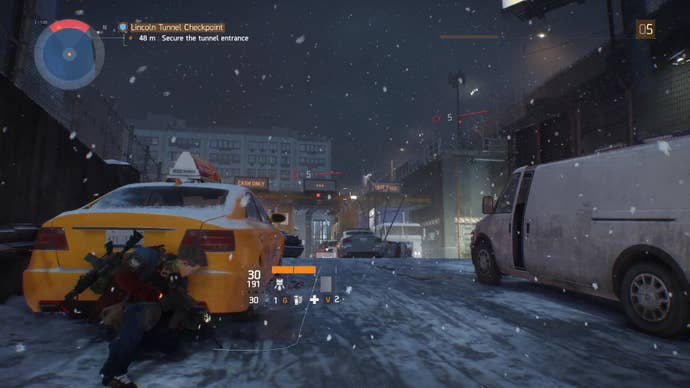
However, you're not just limited to playing specific roles. You can mix and match mods, perks, and skills from each wing to customize your character in any way you see fit, meaning you can create hybrid characters that have a mix of different abilities. It's a neat aspect of the game, and one that gives the player a vast amount of choice in terms of the path they choose to upgrade their character, as well as how they augment their playstyle with different abilities.
Session over, it was time to write a few notes and reflect on my first day's experience in The Division. So far it's been great! Missions have been challenging and entertaining, and while the action seems to boil down to shooting people repeatedly and relentlessly, it's been a varied enough experience to keep me fully engaged. What's clear is that this is a big game, and I've barely scratched its surface. I'm looking forward to seeing what else it has to offer.
InterfaceComplex and occasionally tricky to navigate, but generally very effective.
Lasting AppealThe Division doesn't feature a huge amount of endgame PvE content at launch... but there's always the Dark Zone until new DLC arrives.
SoundThe sparse music really adds to the atmosphere, and the ambient sound effects are excellent.
VisualsAbsolutely brilliant. The Division's post-apocalyptic Manhattan is exceptionally detailed and well realized.
ConclusionFeaturing one of the most remarkable and realistic video game environments ever created, The Division offers a disturbingly dystopian take on a ruined Manhattan. Its action is similarly brutal. Although much of it boils down to firefights and shoot-outs, most are very well executed to deliver truly exciting and thrilling gameplay. Add layers of RPG-like complexity and a really solid storyline, and you have a game that, while occasionally flawed, really does deliver the goods.
WEDNESDAY
This entry in my review-in-progress will probably feel a little staccato, because I'm articulating a series of observations from my notes, rather than writing a narrative, but here goes.
At this point, I'm about sixteen bleary-eyed hours into the game, and am leveling up slowly, but surely. The Division's progression seems to be fairly smooth, and a combination of side missions and main missions, plus the odd encounter here and there has helped my character develop consistently, without the game feeling like a grind. There are certainly plenty of activities to keep you busy, and I've noticed that I've already out-leveled a fair amount of side missions and encounters that I imagine I'll go back to once I reach the end-game to see what I've missed.
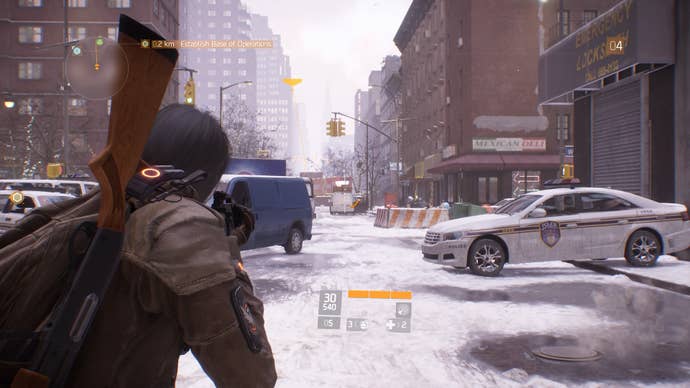
On the whole, my online experience has generally been good. There were a few hours of downtime last night when the servers went offline for maintenance, but other than that, playing has been a fairly smooth experience for me. I have occasionally encountered a server queue to get online during peak hours, but the wait has never been more then a few minutes, so I can't complain too loudly. Your mileage might vary, of course, but so far I haven't had to deal with much in the way of frustration when it comes to server reliability.
The more I explore it, the more impressed I continue to be with The Division's beautifully desolate take on a post-apocalyptic Manhattan. From subway stations stuffed with corpses through looted building interiors to the chaotic, trash-filled streets, there's so much to see and admire in this game, and so many details to capture your interest and fire your imagination. The game is expansive, and there are a myriad of nooks and crannies to explore – it's one of the most fully-realized and immersive environments I've ever experienced in a game, and it still continues to amaze me. It just feels so oppressive, and almost depressing because of what it is essentially conveying. This really does feel like a city gone to ruin, and it's a truly remarkable technical achievement.
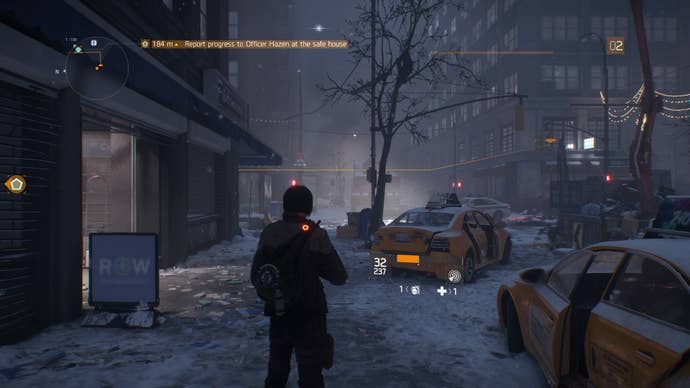
I've praised the AI for generally being quite effective, but I did run into a couple of problems while tackling a side mission just now. It was set in a bus depot, and I was using a marksman rifle to pick off enemies from a distance. For some reason, the main boss kept running back and forth, and every time he did, his health reset. I was probably at the edge of his aggro range, and was triggering some kind of reset, but it was frustrating nevertheless. In the end, I just moved closer to him and that solved the problem, but there definitely seems to be some issues with long-range shots. I've encountered a few other situations where I've been able to take out enemies from a distance without them actually shooting back – probably because I wasn't close enough to set off their aggro. It's a rare enough occurrence not to feel like a consistent exploit, but I've definitely found a marksman's rifle is a great weapon to use for clearing out enemies at range – especially when using it with a scope.
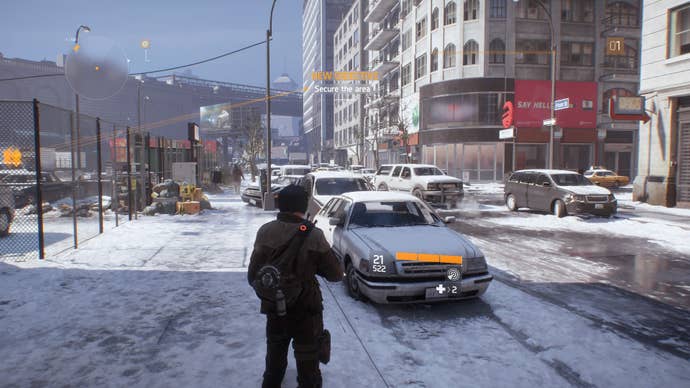
Level demarcation continues to be quite strict in The Division. By that I mean taking on missions and encounters that are above your level – and sometimes not by much – can prove to be very tough. Enemies can be bullet sponges when they're a few levels above you, and I've found myself in a number of situations where I've pumped hundreds of rounds into an enemy character just to take him down. Part of the reason for that is because I've been exploring areas that I probably shouldn't be in, and I end up triggering encounters that I'm not ready for. But even so, it just feels weird to shoot at enemies with an assault rifle and ding them for a few points of damage. It's one of the few situations that I feel breaks the immersion of The Division's experience, and where you can really feel its game mechanics creating something that feels artificial. I know that the cure for this is to stick to activities and areas that are suitable for my level, but I just enjoy exploring.
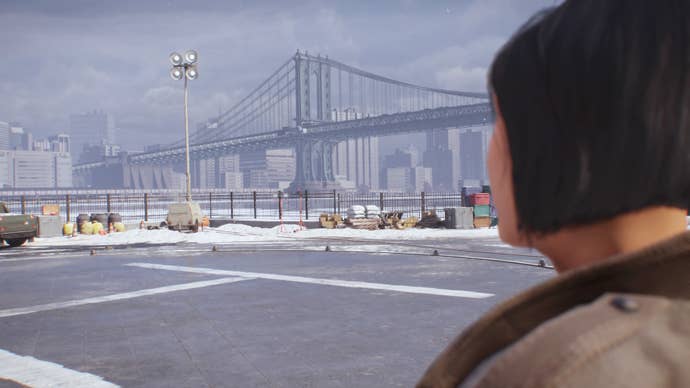
Perhaps it's just me, but I find The Division's cover mechanics can sometimes be a little sticky when moving around corners. I've noticed that I occasionally get hung up on the edges of obstacles – which can be a real bind when you're in the middle of an intense firefight and you're trying to get out of the line of fire. It doesn't happen that often, but when it does, it can have deadly consequences, and that can be frustrating. For the most part, though, the cover mechanics are effective and work well. Running from cover to cover is fine, and I haven't encountered any issues when I haven't been able to get behind cover when I want to. Just watch those corners!
On the whole, I'm finding that I enjoy The Division the most when I'm in a group. While I've tackled a few missions and side missions on my own, the dynamics of group play are just more interesting and exciting. Fortunately, the group matchmaking system seems to work well, and whenever I've wanted to hook up with other players for a mission, it's done its job quickly and efficiently. I feel the game seems to have been designed more with group play in mind, and I find a lot of missions are quite hard when you tackle them on your own, largely because it's easy to get flanked when you have to deal with numerous enemies at once, and especially when they're higher level than you. However, when you join up with even one other player, you can add width to your fire lanes that can stop the enemy from advancing and getting the upper hand. That's not to say The Division isn't a decent single-player game, I just find it's generally easier and more enjoyable when you have company.
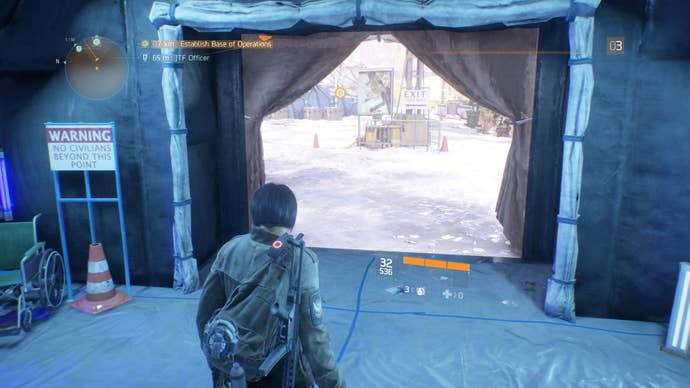
Another aspect of the game I'm enjoying is its drama and storytelling. As you complete missions, there's a distinct feeling of progression, and it really does feel like you're indeed taking back parts of the city – especially when you combine that with the development of the Base of Operations. The excellently-rendered cutscenes help to articulate this well: They're convincingly acted and voiced, and the characters' dialog feels very down-to-earth and realistic. What also adds to the atmosphere is some of the incidental dialog that accompanies side missions and echoes, and even the radio commentary that you hear when you go into safe houses. It just richens the overall experience and helps immerse you deeper into the game.
Before I sign off for today, one thing I would like to say is that I initially had concerns that the overall premise of wandering around a city shooting people in the head would eventually feel somewhat relentless and almost desensitizing, but so far that hasn't come to pass. The game does a good job in justifying its missions and encounters, and whether it's rescuing hostages, protecting civilians from being burned alive, or simply breaking up weapons deals, I always feel that I have good reason to kill the people I need to. I know this is a minor issue, but it's something that helps make me feel like more of a hero than an executioner. While it's mostly a shooter, The Division is also an RPG, and I'm playing a character that I want to feel good about – and so far that's definitely been the case.
InterfaceComplex and occasionally tricky to navigate, but generally very effective.
Lasting AppealThe Division doesn't feature a huge amount of endgame PvE content at launch... but there's always the Dark Zone until new DLC arrives.
SoundThe sparse music really adds to the atmosphere, and the ambient sound effects are excellent.
VisualsAbsolutely brilliant. The Division's post-apocalyptic Manhattan is exceptionally detailed and well realized.
ConclusionFeaturing one of the most remarkable and realistic video game environments ever created, The Division offers a disturbingly dystopian take on a ruined Manhattan. Its action is similarly brutal. Although much of it boils down to firefights and shoot-outs, most are very well executed to deliver truly exciting and thrilling gameplay. Add layers of RPG-like complexity and a really solid storyline, and you have a game that, while occasionally flawed, really does deliver the goods.
Conclusion
Having hit the maximum level of 30 (in a non-rushed 42 hours), and with all the story missions complete, I feel I finally have enough perspective on The Division to conclude this review.
The journey through this game has been a truly memorable one, and exploring the streets of this particular post-apocalyptic Manhattan is something that'll stick with me for a long time. As I've previously said, The Division's chaotic, disturbing environment is very well realized, and I think it's one of the greatest examples of video gaming landscaping (or should that be cityscaping) yet seen. The sheer level of detailing is absolutely incredible, and the exceptional lighting and real-time weather really helps bring it to life.
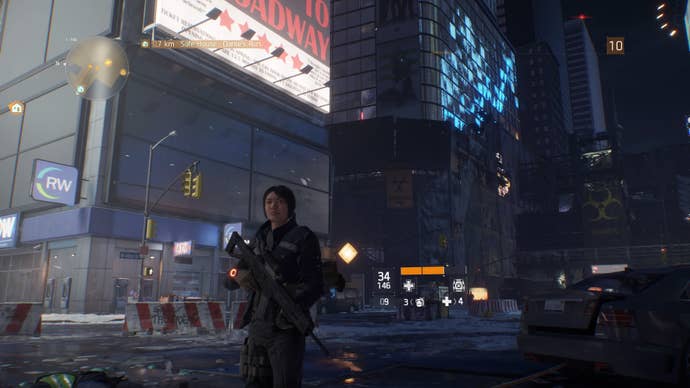
Beyond The Division's run-down, dystopian façade lie some of the most tense and gripping shoot-outs I've tackled in any video game. The story missions are the real stars of the show: They're all basically firefights that largely follow the same kind of structure – shoot waves of bad guys as you progress through the mission's locale – but they vary in style thanks to their creative use of the game's glorious environment. From fighting in the cramped, close-quarters confines of office buildings to trying to stay out of multiple lines of fire in the very open UN Plaza, the story missions are all very well designed to provide action that really gets your adrenaline pumping.
The AI generally works well, and there are enough threats to make most encounters challenging. The tradeoff for this are enemies that are like bullet sponges, but it's something I really didn't think about too much while I was in the midst of the action. The end result is dynamic and intense set pieces where a lot of the time you're trying to survive a hail of incoming bullets by moving from cover to cover, while picking and choosing when to return fire. It just feels really exciting.
While I did tackle a couple of missions solo, I found that they were far more enjoyable when played with a group. Indeed, I'd say that's true for most of the activities in this game. It is perfectly possible to play The Division as a solo player, but I think it's at its best when played with other people, since working as a team is just really enjoyable, plus you're also able to revive one another and coordinate on the use of skills and abilities. Also, the superior numbers of enemies you have to deal with when playing with a squad helps dial up the action and makes fights more interesting. Whether you're attempting to make your way to a downed friend to revive them, or trying to pick off snipers who have got your team pinned down, The Division's multiplayer action often feels like barely-controlled chaos.
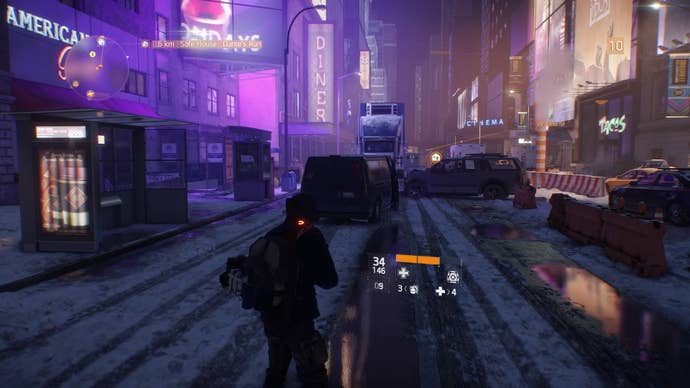
Fortunately, the matchmaking system works very well, and whenever I wanted to play with a team – either for missions or free roaming – it hooked me up with other players very quickly and easily. Like with all games, it can be a bit of a crapshoot who you end up with, and sometimes you might have to go through a few tries before ending up with a group that works for you, but thankfully doing so is straightforward and penalty-free.
The Division is a deep game with many facets, some of which work better than others. I've found that crafting isn't a particularly useful aspect of the game – most of the time, the loot I've received is better than what I could make. Of course, your crafting mileage might vary depending on what you've received as drops, and when you pick up blueprints, but for me it just wasn't something that I found worthwhile. I've also amassed a huge amount of money because, like crafting, most of the drops I'm getting are better than what I can buy. That's not to say I haven’t bought items – it's just that useful pieces tend to be very rare, and most of the time I look, what's on sale just isn't an improvement over what I already have.
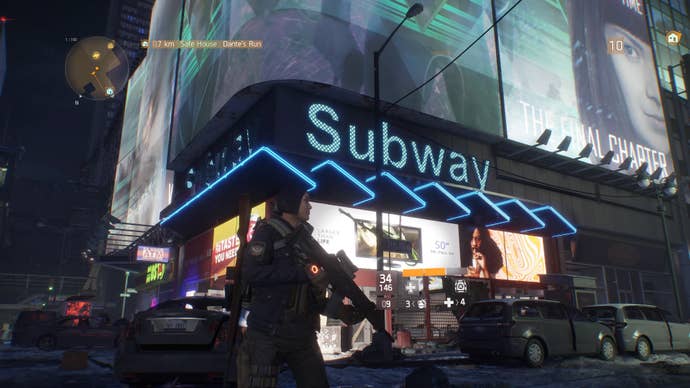
What does work well is character customization. Rather than having specific character archetypes, players can pick and choose whichever skills and abilities they want to use, which can result in a really interesting mix of talents. I went the full medic route, because I love role-playing healers – and that's been great for group play, but I've teamed up with players with all sorts of different talent load-outs, from offensively-oriented, to hybrid healers with defensive shields. It's a great system that lets you augment your playstyle in a very personal fashion.
Loot also lets you customize your character by concentrating on specific stats. You can boost your stamina and be more of a tank-like character (that's me), concentrate more on electronics and boost your skills, or go all-out on DPS by equipping gear with firearms stats. Or indeed, go for a balanced mix. Of course, you'll need to grind for gear to do this, but it's definitely worthwhile to end up with a character that reflects the way that you want to play.
What initially impressed me about The Division was the sheer volume of side missions and encounters there are to tackle. However, what's disappointing is that many of them repeat themselves as you progress through the game. In some situations you're dealing with the same fundamental game mechanics in different locations, such as finding and booting up virus scanners against the clock, while in others you're doing the exact same thing in the exact same environment, such is the case with the water supply encounters. To be honest, I didn't mind doing the same sorts of things repeatedly. The game is pretty much an endless parade of shoot-outs after all, so whether you're defending supplies or helping JTF agents re-take a location, it was all one to me, but some might find that the side missions and encounters do get a little old after a while due to that repetition.
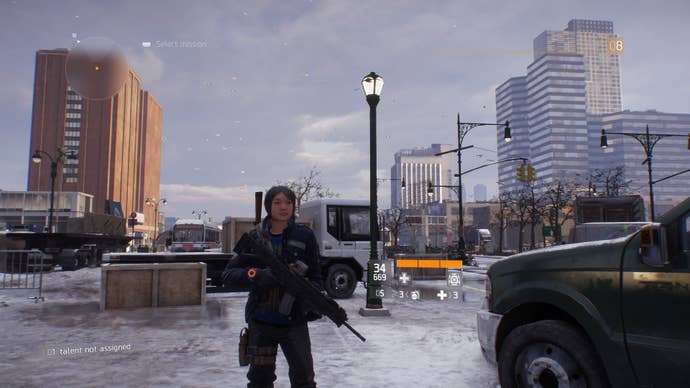
The other aspect of the game that's a little disappointing is the lack of endgame PvE content, especially once you've finished building out your base by completing the encounters you might have missed on your way through the game. I assumed there would be high-end raids available, or something like that, but there aren't any. Sure, you can tackle daily missions on hard – and some of them are really hard – but really, once you reach level 30, it's all about going into the PvP Dark Zone and grinding for loot there.
Fortunately, the Dark Zone is an interesting environment, and that's where I'll end up spending my time when I fancy playing The Division going forward. It's tough and unforgiving, and indeed can sometimes deliver a brutal experience – especially when you get killed carrying some really good superior loot – but that's what makes it so exciting. It's a high-stakes environment where sometimes you can get lucky and meet players who want to cooperate with you, and sometimes you'll run into groups of players who are hunting down individuals. You never quite know what you'll face, and that randomness makes for some tense and thrilling times.
Indeed, tense and thrilling sums up much of my time playing The Division. From its brilliant missions through exploring its amazing environment to tackling its many side missions and encounters, working my way through this game has been a truly enjoyable experience. Sure, the action can be accused of being repetitive, but for me – a hardcore shooter fan – I couldn't get enough of it.
InterfaceComplex and occasionally tricky to navigate, but generally very effective.
Lasting AppealThe Division doesn't feature a huge amount of endgame PvE content at launch... but there's always the Dark Zone until new DLC arrives.
SoundThe sparse music really adds to the atmosphere, and the ambient sound effects are excellent.
VisualsAbsolutely brilliant. The Division's post-apocalyptic Manhattan is exceptionally detailed and well realized.
ConclusionFeaturing one of the most remarkable and realistic video game environments ever created, The Division offers a disturbingly dystopian take on a ruined Manhattan. Its action is similarly brutal. Although much of it boils down to firefights and shoot-outs, most are very well executed to deliver truly exciting and thrilling gameplay. Add layers of RPG-like complexity and a really solid storyline, and you have a game that, while occasionally flawed, really does deliver the goods.

